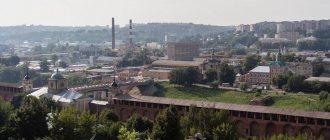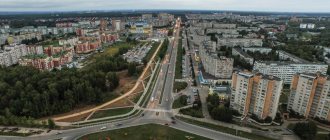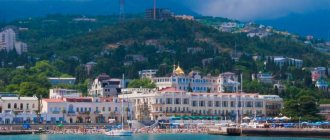- August 11, 2019
- Directions
- Molton
Does everyone know where Irkutsk is? Irkutsk is a large Russian city located in the southeastern part of Siberia, on the banks of the Angara River. It is the capital of the Irkutsk region. The population is 623.5 thousand people. Density – 2252 people/km².
Irkutsk is an ancient city. It was founded in 1661. Thanks to this, it became a candidate for inclusion in the UNESCO World Heritage List. Irkutsk is a major scientific and educational center. Sectors such as hydropower, aircraft manufacturing and food production are developed here.
Where is Irkutsk on the time zone map? Time in Irkutsk corresponds to Chinese (time zone UTC+8). The time difference between Irkutsk and Moscow is 5 hours. It's not that much.
The coat of arms of Irkutsk was approved in 1997. It is a heraldic shield of silver color. It depicts a black “babr” holding a scarlet sable in its mouth. Babr is a large, fierce and strong animal, which is classified as a member of the tiger family.
Geographical features
Irkutsk is located somewhere in the East Siberian region, on both sides of the Angara River. The closest city to it is Ulan-Ude, the distance to which is 439 km. Of the large million-plus cities, the closest is Krasnoyarsk. The distance to it in a straight line is 850 km. As for the distance to the capital of Russia - Moscow, it is 5200 km.
The relief of Irkutsk is flat and hilly. Landscape zone – forest-steppe. Near the city there is a reservoir of the same name. It is closed by the dam of the Irkutsk hydroelectric station.
About the city
Irkutsk is a unique, ancient city, an ancient crossroads of trade routes, the capital of Eastern Siberia. It is located at a distance of 5042 kilometers from Moscow and located on the banks of the Angara River, 63 kilometers from Lake Baikal. The territory of the city of Irkutsk occupies 27,998 hectares.
Irkutsk was founded as a fort in 1661 on the right bank of the Angara, in 1686 it was given the status of a city, and since 1764 it has been the center of the Irkutsk province. Irkutsk is located at the intersection of transport routes connecting the west and east of Russia, as well as Russia with China and Mongolia. The Trans-Siberian Railway and the M-55 Moscow-Vladivostok federal highway pass through Irkutsk. Irkutsk International Airport is an important stopover point for airlines connecting airports in Southeast Asia and the Far East with the European part of Russia and the CIS countries.
The recreational potential of Lake Baikal is of great interest for investment. The area of territories suitable for the development of ecological tourism reaches several tens of thousands of square kilometers. According to forecasts, up to 2 million people can vacation on the coast of Lake Baikal every year.
Modern Irkutsk is a historical city, successfully combining the grandeur and originality of the historical center and modern building blocks, the traditions of the most intelligent and cultural Siberian city with modern industrial, scientific and educational potential, and developed infrastructure.
Irkutsk has four administrative districts: Pravoberezhny, Oktyabrsky, Sverdlovsky and Leninsky.
Irkutsk today is a large administrative, industrial, trade, cultural and scientific center of Eastern Siberia, home to more than 600 thousand residents. The national composition of the city's population is diverse and amounts to over 120 nationalities.
Science and education
Irkutsk is one of the largest scientific and educational centers in Siberia. There are 16 academic institutions of the Siberian Branch of the Russian Academy of Sciences in the city.
There are 17 higher educational institutions in the city (including 15 public ones); 25 educational organizations of secondary vocational education; 135 preschool educational institutions; 78 daytime comprehensive schools (including 72 municipal); 2 municipal evening (shift) educational institutions; 12 regional special (correctional) educational institutions; 16 municipal institutions of additional education.
Healthcare
Medical care is provided to residents of the city of Irkutsk by 60 healthcare institutions of various departmental subordination, including 30 municipal ones. The total bed capacity in the city’s hospitals is 11.6 thousand beds, of which 10.4 thousand are inpatient, the design capacity of outpatient clinics is 20.3 thousand visits per shift.
The structure of the municipal healthcare system includes 28 medical and preventive institutions, the municipal health care institution “Automotive Transport Facility” and the municipal health care institution “Children’s Dairy Kitchen”. Medical care to the population of Irkutsk is provided by 8 hospital and polyclinic complexes, 4 hospitals, 14 clinics, the City Perinatal Center, and the City Emergency Medical Service Station.
The city has such unique healthcare institutions as the Diagnostic Center, Regional Oncology Center, Dikul Center and others.
Culture
On the territory of Irkutsk there are 107 cultural and art institutions of various forms of ownership and their branches, of which 52 are municipal. The network of municipal cultural institutions includes: a folk drama theater, a museum of the history of Irkutsk with 4 branches, a municipal cultural institution "City Park", 14 children's music, art and art schools, 28 libraries of the Centralized Library System, a Humanitarian Center - a library named after the Polev family, a children's dance group "Solnyshko", children's creative leisure.
The city is known for its school of fine arts, theater school, and two writing organizations. Irkutsk is the birthplace of world-famous writers Valentin Rasputin and Alexander Vampilov, director Leonid Gaidai, actor Nikolai Okhlopkov, and pianist Denis Matsuev.
Sport
To organize and conduct physical education, recreation and sports events, as well as to improve the highest skills of athletes in the city of Irkutsk, there are 1,029 sports facilities of various forms of ownership, including 800 municipal ones. The city's network of sports facilities includes: 7 stadiums, 2 athletics arenas, 3 indoor sports facilities with artificial ice, 228 flat structures, 203 gyms, 32 swimming pools, 2 ski resorts, 10 facilities for shooting sports, 3 climbing walls and 539 urban and recreational infrastructure adapted for physical education and sports.
Industry
Irkutsk is a large industrial center of Eastern Siberia. The industrial profile of the city is diverse: production of vehicles, machinery and equipment, non-metallic mineral products, food products, chemical, textile and clothing production, production and distribution of electricity, gas and water, etc.
57 large and medium-sized industrial enterprises are engaged in the production and shipment of goods of their own production, performance of works and services in Irkutsk.
The products of the Irkutsk Aviation Plant - a branch of OJSC Irkut Corporation - multifunctional aircraft equipment (SU-30MK, Be-200), as well as the Irkutsk Heavy Engineering Plant (gold mining, metallurgical and mining equipment) are supplied to enterprises in Russia, Kazakhstan, Ukraine, to India, Pakistan, Turkey, Iran, Egypt, Algeria, Burma and other countries. The wide range of products of JSC Relay Plant are used in automation installations in railway transport, in the aviation and automotive industries, transport engineering and in household appliances. One of the leading enterprises for the production of fat and oil products, soybean flour, feed meal in Russia, the leader of production in Siberia and the Far East is Irkutsk Oil and Fat Plant OJSC. Irkutsk residents and guests of the city are well aware of the wide range of products produced by Irkutsk Bread CJSC and Irkutsk Maslosyrbaza OJSC.
Energy
Irkutsk is rightfully considered one of the largest energy-producing centers in Russia. Within its boundaries are located the first of the cascade of hydroelectric power stations on the Angara - the Irkutsk Hydroelectric Power Station with a capacity of 660 MW and the Novo-Irkutsk Thermal Power Plant with a capacity of 655 MW. The total annual electricity production of these two enterprises exceeds 6 billion kWh. Both of them are part of OAO Irkutskenergo, which unites the work of all energy enterprises in the region: 3 hydroelectric power plants, 9 thermal power plants, electrical and thermal networks. Irkutskenergo ranks second in Russia in the production of thermal energy and third in the production of electricity. Due to the use of the Angarsk cascade of hydroelectric power stations, Irkutsk energy is much cheaper than that generated at nuclear power plants.
Consumer market
The retail trade network of Irkutsk includes 1,119 stores (574 food and 545 non-food), 423 kiosks, 741 pavilions, 56 shopping centers, 22 retail markets.
There are 877 public catering enterprises operating in the city's consumer market: 55 restaurants, 294 cafes, 148 bars, 97 snack bars, cafeterias and culinary stores.
Small business
There are 1,776 small enterprises operating in the city of Irkutsk, the average number of employees is 33,468 people. The number of individual entrepreneurs is 21,661.
Small businesses operate in all types of economic activities. Among them, the largest share is occupied by wholesale and retail trade enterprises, operations with real estate, rental and provision of services, and construction. Small manufacturing enterprises are actively developing - 180 units.
Transport
Irkutsk is a major transport hub in Eastern Siberia. It houses the Administration of the East Siberian Railway - a branch of JSC Russian Railways, an international airport, the East Siberian River Shipping Company, a river port, and large enterprises of automobile and electric transport. The rolling stock fleet of municipal passenger transport enterprises is 312 units: 182 buses (of which 101 are large-capacity buses and 81 are medium-capacity buses), 58 trams, 72 trolleybuses. During the reporting period, on average, 115 municipal buses, 37 trams, 56 trolleybuses and more than 1,400 commercial buses operated on city routes daily.
The international cooperation
Since 1967, the city of Irkutsk has been gaining experience in establishing and strengthening good relations with cities of the world. Today, 11 cities are twin cities and partners of the city of Irkutsk:
- Kanazawa (Japan) since 1967,
— Ulaanbaatar (Mongolia) since the mid-1970s,
— Eugene (USA) since 1988,
— Shenyang (China) since 1992,
— Pforzheim (Germany) since 1999,
- Haute-Savoie department (France) - the cities of Ville-la-Grand, Annecy, Evian, Seino, etc. since 2001,
- Strömsund municipality (Sweden) since 2001,
- Province of Pordenone (Italy) since 2005,
— Simferopol (Russia) since 2008,
— Gangneung (Republic of Korea) since 2009,
— Vilnius (Lithuanian Republic) since 2010
— Karlovy Vary region (Czech Republic) since 2011
What is the climate in Irkutsk?
The great distance from the Atlantic Ocean and the abundance of mountains in this region of Siberia cause a cold and sharply continental climate. The daily and annual temperature ranges here are very large. So, between winter and summer the difference is about 70 °C, but it can be more. The average annual temperature is 1 °C.
Winter is quite long and harsh. It lasts over 5 months: from late October to early April. Frosty, clear and windless weather is typical during this period. The average temperature in January is 17-18 degrees minus.
After a short and dry spring, a hot summer comes. However, in the second half it often rains, which brings down the heat. Autumn is dry and warm, with large daily temperature fluctuations.
The wettest month is July (precipitation amount - 114 mm). And the driest month is February (8 mm). The annual precipitation amount is 480 mm. Up to 4/5 of their total number occurs in the warm period of the year (May–September).
The record holder for the amount of precipitation was 1938. Then 797 mm fell. And the driest was 1884 - only 209 mm.
Winds are more common during transition seasons. In general, windiness is low - only 2.1 m/s on average for the year.
The reservoir makes the climate wetter and increases the frequency of fogs. It has the greatest influence on the weather in the autumn-winter period.
The duration of the frost-free period is 95 days.
Ethnic composition
The total population of the city of Irkutsk is represented not only by Russians, but also by other nationalities, which form the total population for 2010. This includes:
- Russians – more than 501,000.
- The second largest population are the Buryats - more than 12,000.
- Ukrainians and Tatars are present here in approximately the same percentage – about 5,000.
- The Azerbaijani, Kyrgyz, and Armenian diasporas are represented by residents - just over 2,000.
- The least numerous are Uzbeks, Tajiks, Belarusians, Tuvans and Jews. There are a little more than 1 thousand of them.
Ecology of Irkutsk
The main pollutants of urban air are motor transport and heat power. Moreover, the role of the first is especially great, and industrial facilities make a minor contribution. In 2010, the norms for benzopyrene were exceeded by 10 times, and for formaldehyde – by 6 times. Both substances are possible carcinogens. For other pollutants, the excesses are not so significant. An increase in the number of cars also contributes to an increase in pollution. Stagnation and settling of air in an anticyclone obviously leads to an increase in the concentration of harmful substances in the surface layer of air.
Statistics by year
If we talk about the population of the city of Irkutsk, here is how it has changed over the past 170 years:
- In 1856, when the first statistical census was carried out, confirming 24,100 people.
- By the post-revolutionary year of 1923 it had increased to 88,264.
- In 1831 there were 113,215.
- By 1839 it had more than doubled - to 250.181.
- In 1956 it was 314,000.
- In 1962 - 385,000 people.
- Already in 1975, 516,000 people began to live here.
- By 1985 – 601,000.
- By 1990 - 582,000.
- In 1995, the number of living citizens decreased even further, resulting in a figure of 581,000.
- But for the 2000 calendar period, the composition here reached 593,700.
- In 2005 – 582,500.
- In 2010 – 587.891.
- In 2015 – 620.099.
- For 2022 – 623.479.
Over more than 170 years of history, the population has increased more than 25 times. True, at the same time it is worth noting that over the past 5 years, until 2022, it has remained virtually unchanged in number and density. The figure fluctuates around 623,000, showing periodic growth and then a short fall, within a few 100 people.
Migration
If we talk about resettlement, the following figures are given for 2022:
- The number of arrivals is about 43,000.
- The number of those who left is 46,000.
Migration of the Irkutsk region
Thus, it is necessary to take into account that despite a fairly developed infrastructure and functioning industrial enterprises, numerous universities, cultural and other entertainment institutions, some of the townspeople are trying to move. Moreover, some move within the country, while others move to other states.
Healthcare.
There are 46 municipal healthcare institutions in the city, and 8 municipal medical programs. The Irkutsk branch of the Interdisciplinary Scientific and Technical Complex “Eye Microsurgery”, a Diagnostic Center, centers for alternative medicine, medical social, psychological and psychotherapeutic assistance have been created. In 1987, the East Siberian branch of the Siberian Branch of the Academy of Medical Sciences was opened in Irkutsk, designed to coordinate medical research at the regional level.
Transport.
Irkutsk is the largest transport hub on the Trans-Siberian Railway. Irkutsk Airport delivers passengers to Moscow, Vladivostok, other cities of Russia, and to international airports in China, Mongolia, Japan and other countries.
The urban passenger transport system in 2003 included 387 buses (of which 247 were depreciated and required write-off), 73 trams, 78 trolleybuses and 160 minibuses. Passenger transportation was carried out along 41 bus, 8 trolleybus routes (length over 40 km) and 5 tram routes (length 24 km). The volume of traffic amounted to 130.1 million people (for 2003), which is 16.2 million less than for the same period in 2002.
Flag
The flag of Irkutsk is made in the form of a rectangular panel. Elements of the coat of arms are depicted on both sides. They are shifted towards the shaft. The ratio of the distance of the center of the babr image from the left edge to the length of the panel is 1:3. The ratio of the width of the blue stripe in the lower part to the height of the panel is 1:4. This is the only Russian flag that has a non-standard shape. The lower blue stripe ends with a slope (braid).
The artistic composition was approved by the decision of the City Duma of October 31, 1996 No. 3-29gD (2). Included in the State Heraldic Register of the Russian Federation under No. 133.
Popular message topics
- Green algae
A group of simple algae got their name due to the chlorophyll that is present in the cells and gives a green color to tissues. There are almost 20 thousand species with similar biochemical characteristics. - Black Sea Coast
The Black Sea coast is an impressive territory, which includes several coastal strips and islands. If we talk about the length of the coastline, then it will take a long time to figure it out. Each researcher has his own data - Where did the numbers come from?
When ancient people started hunting animals, they needed to calculate how many people should go hunting. It was necessary to invent a counting system. The leaders of such ancient settlements coped with this task, it’s even hard to believe how.










